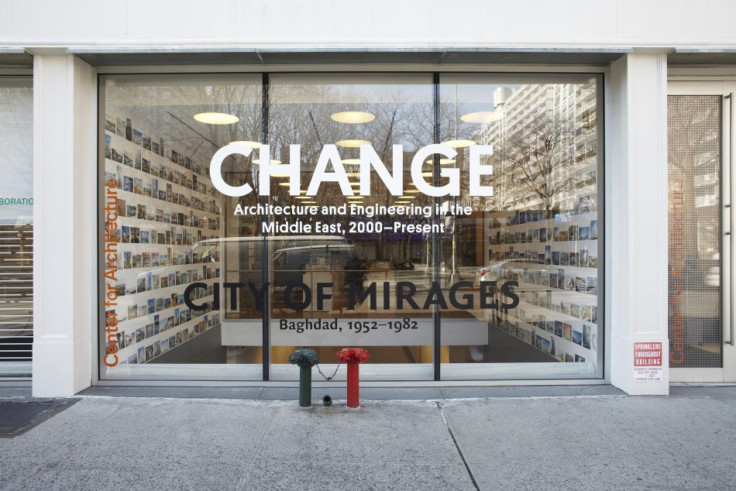Assumptions of Middle East Architecture Challenged in New York Exhibition
Building New York

(AIANY)
The West and the Middle East have long had a strained political relationship. But when it comes to architecture, a more fruitful partnership has emerged.
Two new exhibits at the New York Chapter of American Institute of Architects's Center for Architecture in Manhattan trace mid-century planning in Baghdad, a city better known now for its destruction than development, and the building boom of the last decade in the broader Middle East.
The exhibits challenge assumptions about the region and provide some startling revelations.
City of Mirages: Baghdad, 1952-1982, chronicles the dreams of architects at mid-century, including giants like Le Corbusier and Frank Lloyd Wright.
The image that most people have of Baghdad is war, said Rosamond Fletcher, the AIANY's director of exhibitions. We were very interested in showing something of the city that was -- both in people’s imagination and the projects that were built.
The exhibit, organized by Pedro Azara and the Collegi d'Arquitectes de Catalunya in Barcelona, includes models, sketches and an expansive aerial model of the city. The various designs reinforce the disruptive force of revolution and invasion, turning what was envisioned as a global jewel into a place of unrealized potential.
Le Corbusier designed an Olympic Stadium for Baghdad near the end of his life, which was to form the centerpiece of the city's unsuccessful 1960 Olympic bid. Ultimately, the project did not move forward until Saddam Hussein assumed power and was only partially realized, with a gymnasium being built. It currently serves a local youth team.
Even completed projects were compromised by subsequent events. Spanish architect Josep Lluís Sert designed the first U.S. Embassy, which was replaced in 2009 with a modern facility and damaged by war. Its future remains uncertain.
Many other projects were conceived, but never materialized. Black and white images form an impression of what could have been.
(AIANY)
Change: Architecture and Engineering in the Middle East, 2000-Present offers a more vigorous overview of the region's recent changes.
To ensure that the scope of the exhibit reflected the full breadth of the Middle East, the AIANY solicited 123 projects from both large Western firms and smaller, local firms. Only around 5 percent of the images are unbuilt renderings, said Hassan Radoine, curator of Change and chairman of the architectural engineering department of the University of Sharjah's College of Engineering in the United Arab Emirates.
With such a large tapestry of work, organization was a challenge. The stereotype is that the Middle East is one entity, said Radoine.
After contemplating a division by themes, the organizers grouped the buildings in five geographic clusters: the oil-saturated Persian Gulf; North Africa; the Sham region, which includes Syria, Lebanon, Jordan and the Palestinian regions; the trio of Turkey, Iran and Iraq; and Israel.
Inevitably, the Gulf provides the bulk of the work, comprising nearly half of the entire gallery, and its largest projects. Skidmore Owings & Merrill's Burj Kurj Khalifa, currently the world's tallest building, joins 38 other supertall towers over 300 meters.
Although they provide the most visible element of the skyline, the new spires represent only a fraction of development. On the smaller scale, a wave of research and educational facilities have been built in the Gulf, including Western arrivals like New York University and Cornell University. Housing, from luxury villas to more modest abodes, cultural theme parks and government buildings also are displayed. Historic preservation is also an element, although it is often overlooked among the surge of new projects.
Moving forward, concerns have gone horizontal. Energy efficiency, relating to the urban fabric and reconciling the region's new arrivals with its historic past are the emerging challenges.
Dubai is moving from the iconic architecture and fragmented urban studies to integrating with the community, said Radoine.
But it still has a reputation as an architecture playground, fueled by oil riches and removed from the realities of post-recession design. The emphasis on spectacle over usability, or to paraphrase the recent Pritzker Prize winner Wang Shu, houses over homes, is a danger, said Radoine.
He cites two works by the acclaimed Iranian-British architect Zaha Hadid, her Grand Theatre Rabat in Morocco and the Abu Dhabi Performing Arts Centre, as virtual mirror images, space age constructs that do little to relate to their immediate surroundings.
They are developing a cliché -- iconic architecture that will make them famous, said Radoine.
--
City of Mirages runs through May 5 and Change runs through June 23 at the AIANY's Center for Architecture at 536 LaGuardia Place, New York, NY. Admission is free to the public. www,aiany.org
© Copyright IBTimes 2025. All rights reserved.





















